The new director of National Institute of Allergy and Infectious Diseases (NIAID), Dr. Jeanne Marrazzo joined AVAC Executive Director in conversation.
AVAC in Conversation with NIAID’s Jeanne Marrazzo
Webinars to Look Out for in February!
2024 is off and running and a slew of webinars are on the calendar. This selection of topics is both broad and deep, providing updates on the pipeline from cure to vaccines, insights on critical advocacy, a conversation with the new director of NIAID, and opportunities for you to engage. Scroll down for what’s coming up and recordings of webinars from December and January that you may have missed.
Coming up!
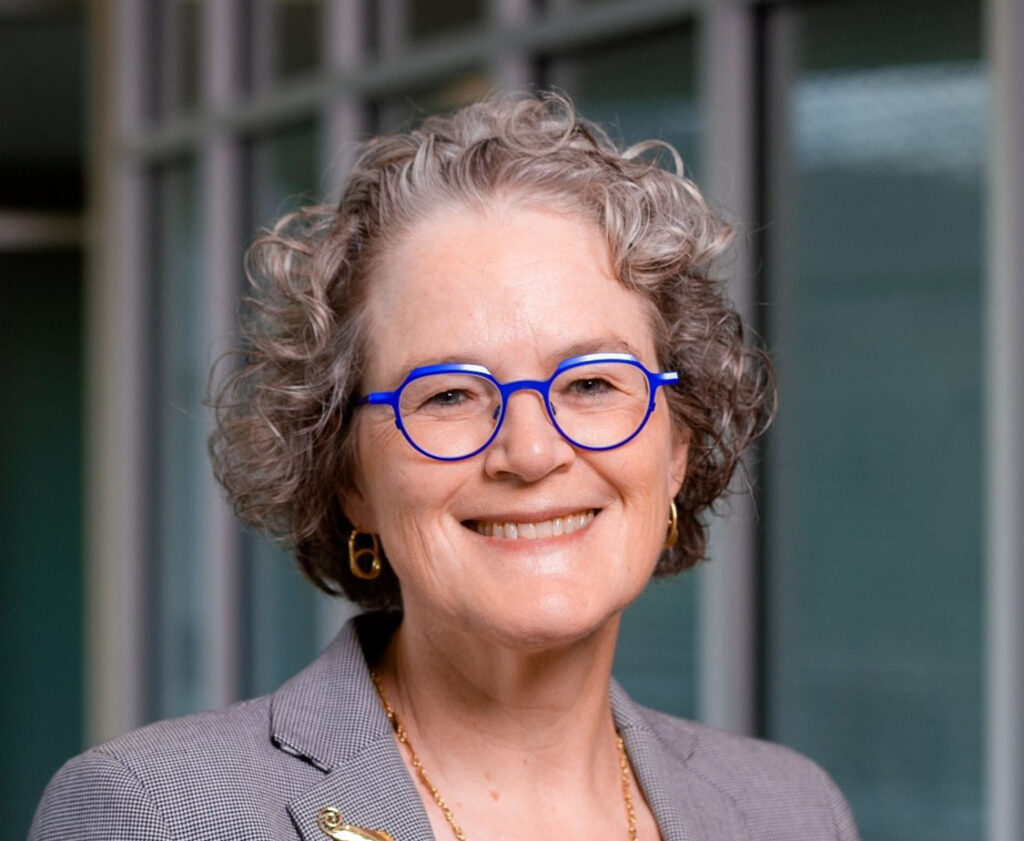
AVAC in Conversation with NIAID’s Jeanne Marrazzo
February 27, 11:30 am – 12:00 pm EST
Join AVAC in conversation with the new Director of NIAID, Jeanne Marrazzo. Register here.
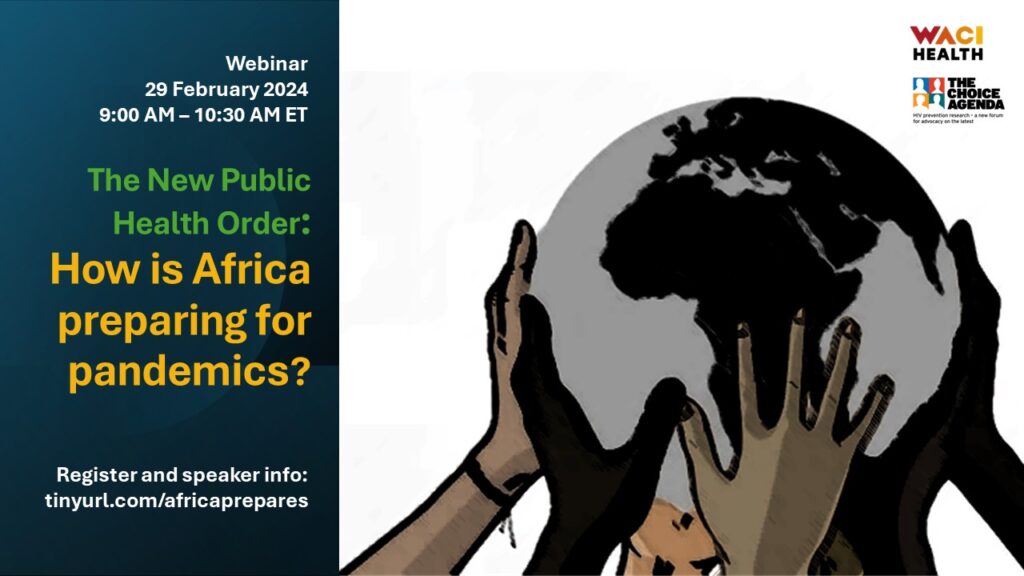
The New Public Health Order: How is Africa preparing for pandemics?
February 29, 9:00-10:30 am EST
WACI Health and The Choice Agenda invite you to join us for a webinar introducing key initiatives of the Africa CDC and the African Union. It will illuminate roles for civil society and community engagement. Register here.
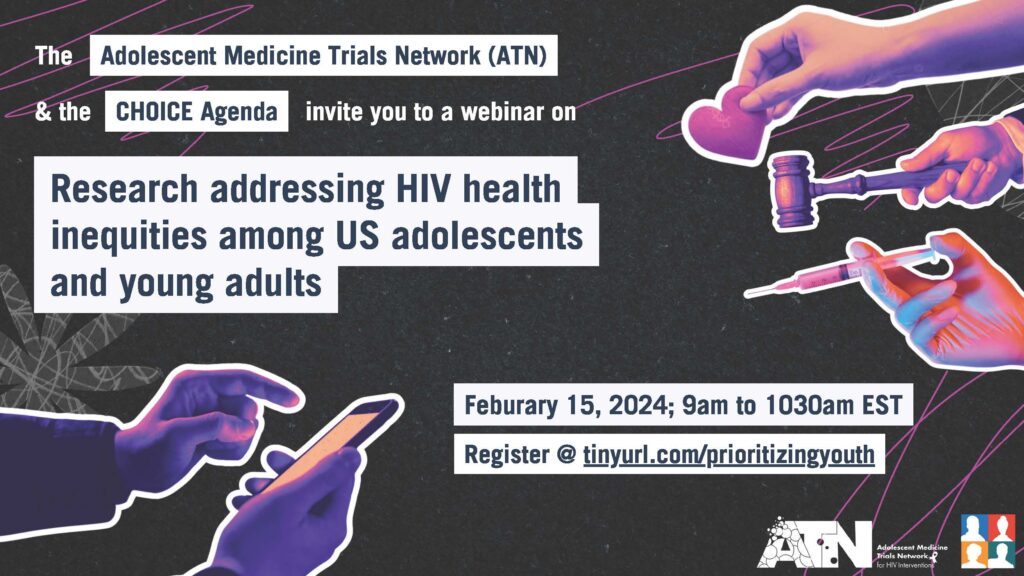
Join The Choice Agenda for an overview of the newest cycle of the Adolescent Medicine Trials Network! This webinar includes highlights of: ATN 165: Linking Youth to PrEP Services, which tests an innovative mobile delivery and mHealth intervention for PrEP adherence and persistence among sexual minority men; ATN 167: Legal, Economic, and Affirming Peer Support (LEAP) for transgender and gender diverse youth; and how the network prioritizes and amplifies the voices of youth directly impacted by the ATN’s pivotal research. Register here.
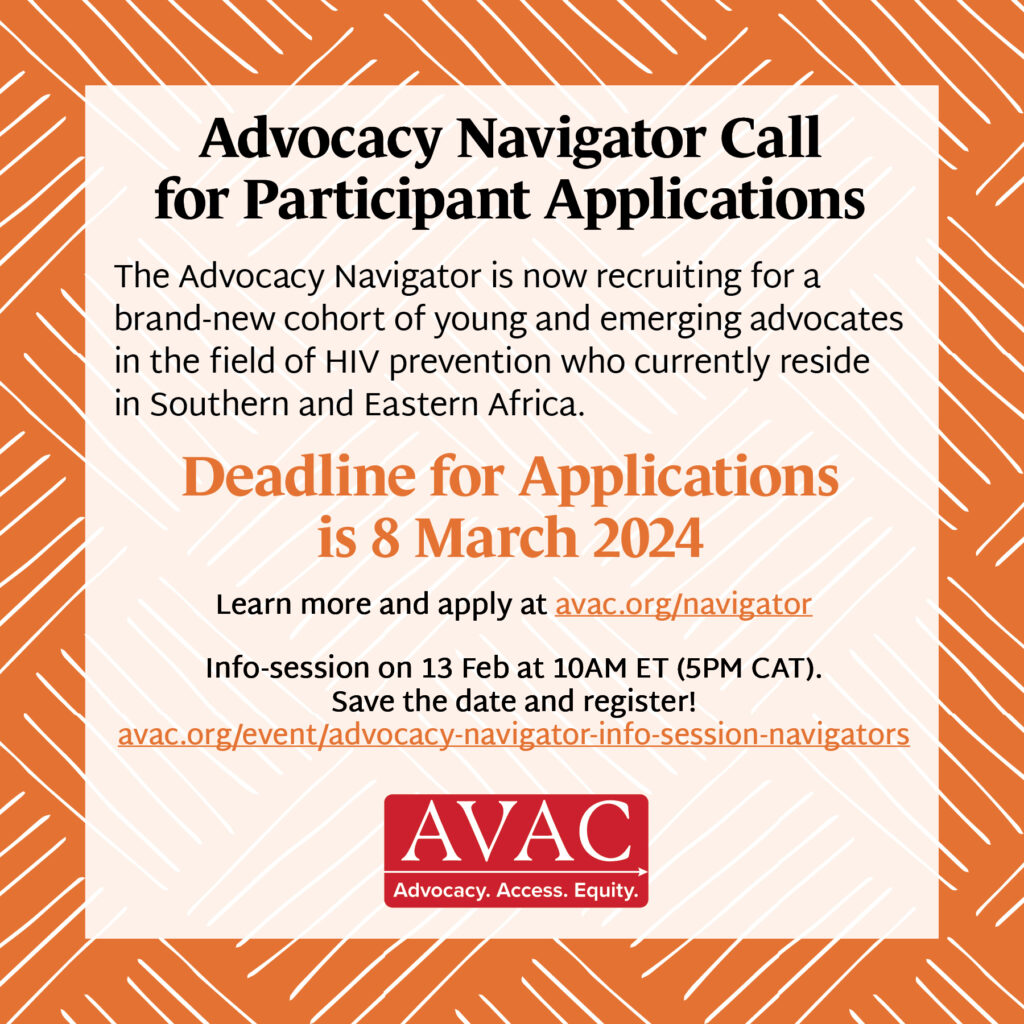
Advocacy Navigator Program Info Session
February 13, 10:00-11:00 am EST
This webinar is intended for anyone interested in applying to participate in AVAC’s Advocacy Navigator program. The session will provide an overview of the program, expectations, eligibility, and application process, followed by Q&A with the AVAC team.
In case you missed it!
Reporting the African Science Story: Decoding scientific research to support public health in Africa
Through the Media Science Café Program, AVAC partners with health media associations in Kenya, Tanzania, Uganda, Zambia and Zimbabwe to bring journalists together with researchers, implementers, civil society, policy makers, regulators and policy makers to build relationships that will foster accurate reporting of HIV, COVID and other science or health stories in those countries. Learn about the model! Recording, slides and resources.
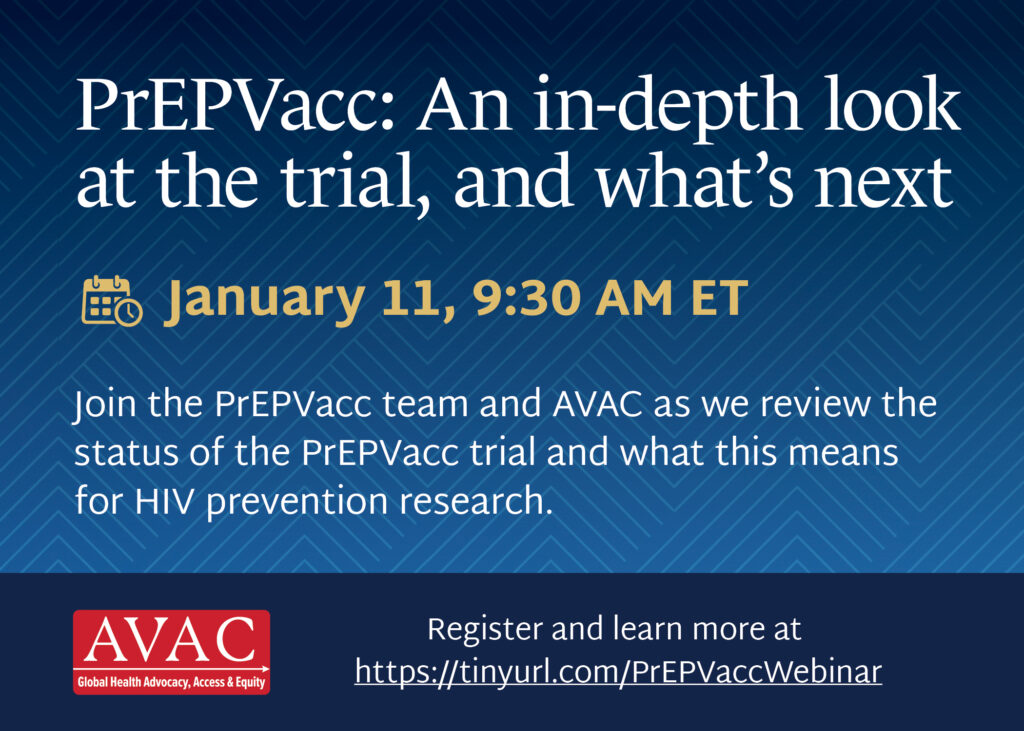
PrEPVacc: An in-depth look at the trial, and what’s next
This webinar reviewed key aspects of PrEPVacc, including its innovative study design, implementation, integrated social science, and data analysis plans. An engaging conversation about what we’ve learned from PrEPVacc, what we can still learn, and what this may mean for the HIV prevention field. Recording, slides and resources.
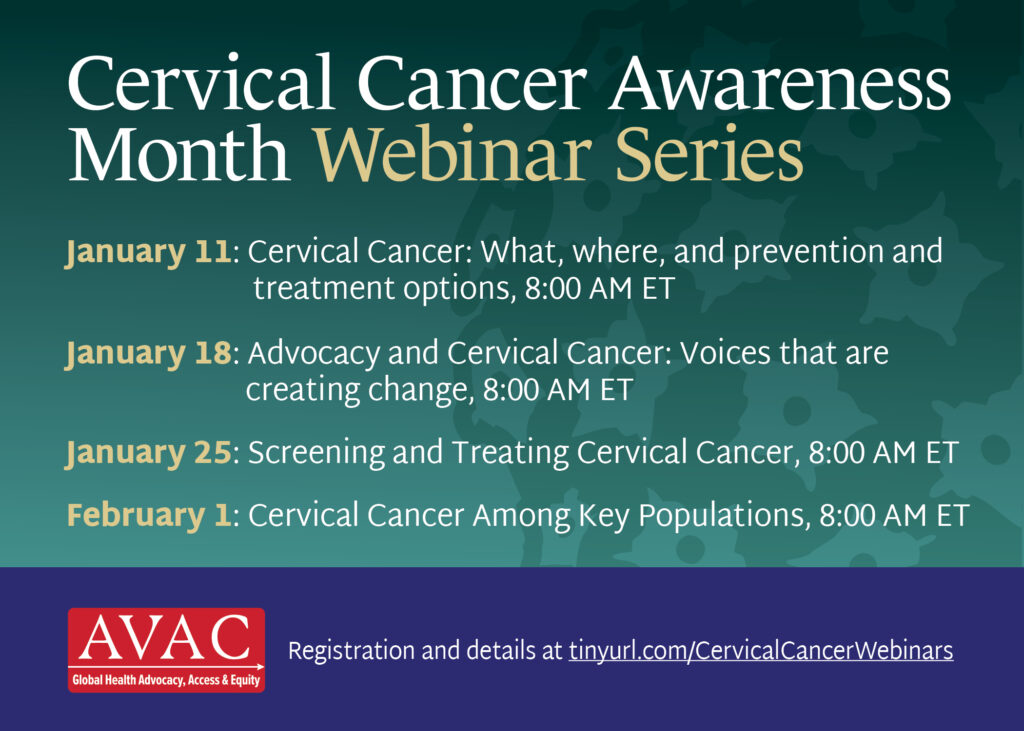
Cervical Cancer Awareness Month Webinar Series
Check out our 4-part webinar series on cervical cancer, which featured a deep dive on: what cervical cancer is, who is impacted, and prevention and treatment options; advocacy strategies to bring more attention to cervical cancer and its impact on communities; options for screening and treating cervical cancer along with ongoing research; and the impact of cervical cancer on key populations and those vulnerable to HIV infections. Recording, slides and resources.
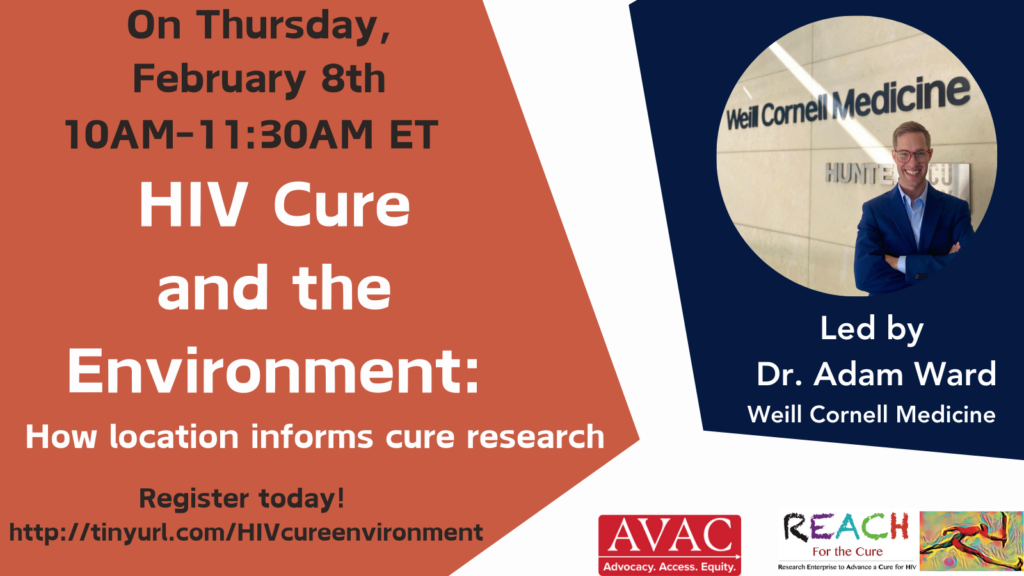
HIV Cure and the Environment: How location informs cure research
This webinar reviewed core concepts discussed in the previous webinar, Let’s Talk About HIV Cure Research: An Introduction to the science under investigation, and introduced how the environment may impact cure strategies. Recording, slides and resources.
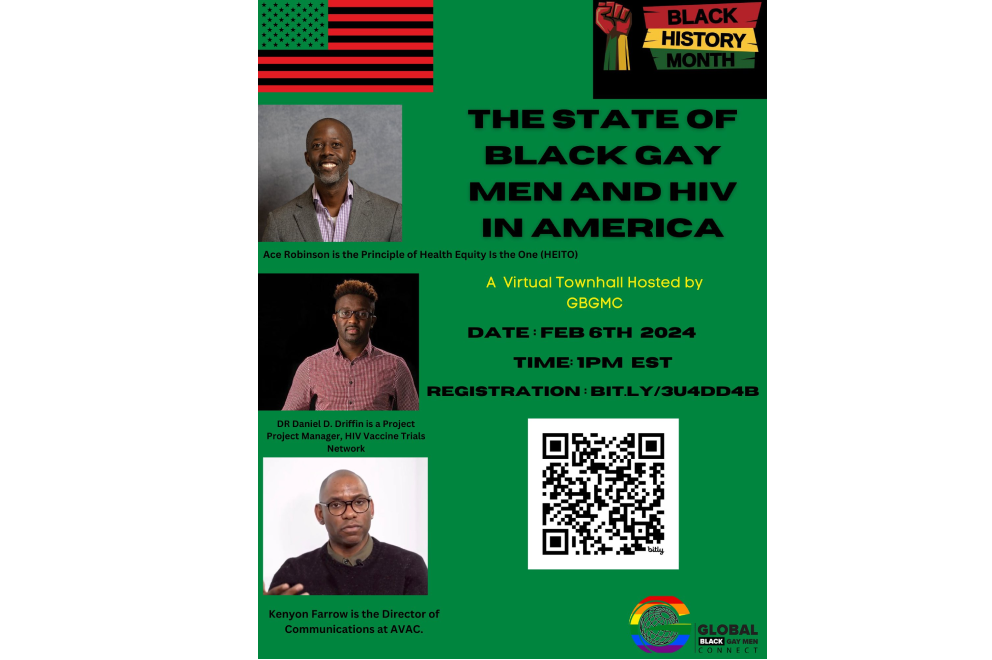
Learn more about the townhall discussion on Black Gay Men and HIV in the US featuring influential figures in the Black Gay community, including Ace Robinson, Daniel D. Driffin, and Kenyon Farrow by checking out highlights on AVAC’s Twitter page and watch the full recording.
Thanks for checking out these conversations. We hope you will join us in these rich discussions and watch this space for future webinars!
Now accepting applications for the 2024 Advocacy Navigator program
Dear Advocate,
Following a successful 2023 program, AVAC is delighted to launch the 2024 Advocacy Navigator program and invites applications from emerging advocates from Eastern and Southern Africa interested in strengthening their skills in HIV prevention advocacy. Applications for the Advocacy Navigator program are now being accepted through 8 March 2024.
Find details about the Advocacy Navigator program and application process here. And join us for an informational webinar on Tuesday, 13 February.
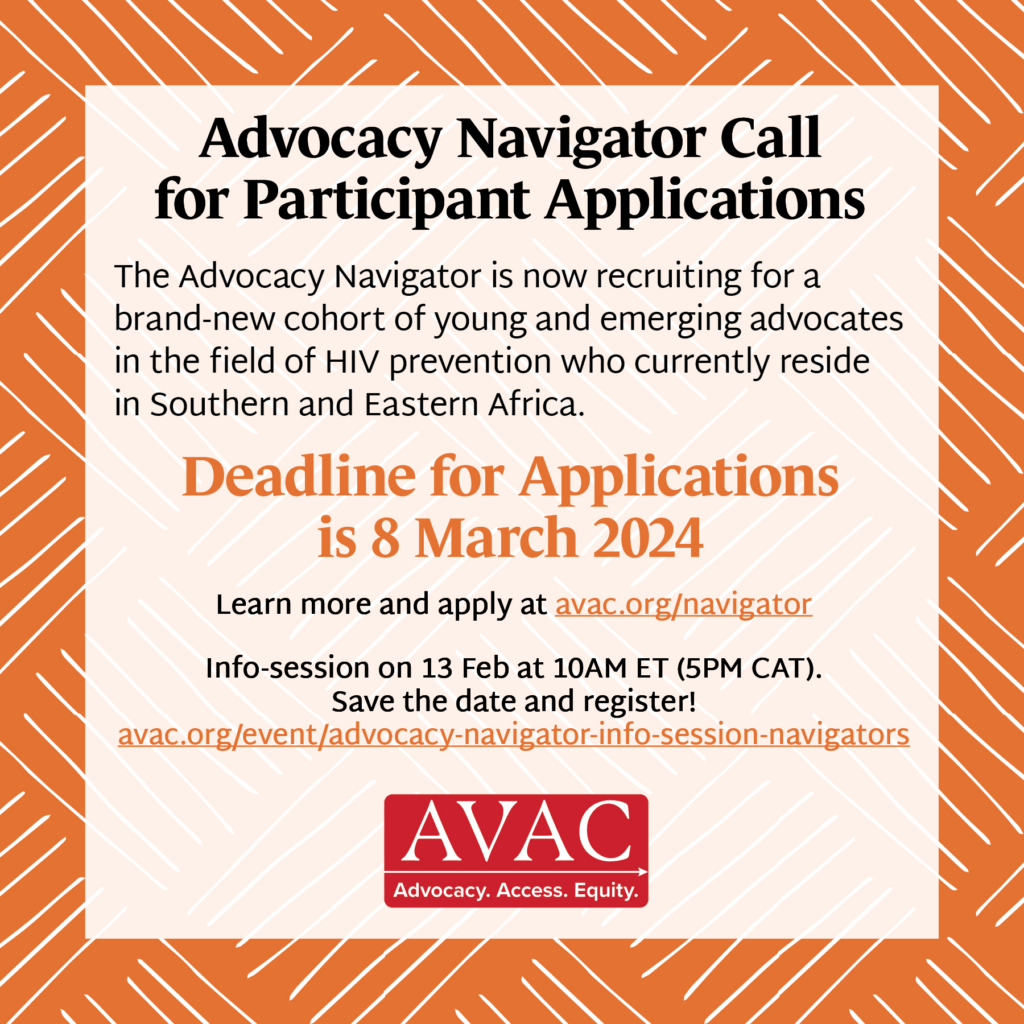
The Advocacy Navigator combines training and mentorship for young and emerging advocates in the field of HIV prevention advocacy. The program brings together a small group of individuals for online knowledge- and skills-sharing sessions and pairs them with a mentor from AVAC’s alumni Fellows’ network to apply their learning to a community advocacy project. The program begins with three months of coursework and project development, followed by three months of implementation, when advocates work on their plans.
Twelve advocates from nine countries across Africa completed the Advocacy Navigator program in 2023. Their community projects ranged from advocacy for the introduction of and access to new prevention methods including the dapivirine vaginal ring and injectable PrEP, to the need for more available data for key populations, to a call for expanding choice in HIV prevention. Read testimonials from their experience here.
“It’s not a one-size-fits-all approach; rather, it’s about recognizing the diversity of needs and implementing interventions that truly make a difference. It’s been eye-opening to witness how empowering individuals with the knowledge and skills to advocate for their rights and educate their peers can be a catalyst for change. This project has instilled in me the belief that advocacy is not just about speaking up; it’s about equipping those affected by an issue with the tools they need to be the agents of change themselves.”
– Doreen Moraa Moracha, Advocacy Navigator 2023 (Kenya)
Since launching the AVAC Fellows program in 2009, AVAC has recognized the imperative to invest in mobilizing a growing cadre of HIV prevention advocates. The Advocacy Navigator program is leveraging the strength of this extraordinary alumni community to sustainably expand this model through a short online learning and mentorship program to a larger number of people.
Find the application and additional information at AVAC.org/navigator.
Even a baseline level of meaningful civil society engagement within international fora will do
By Sam Rick, Multilateral Engagement and Pandemic Preparedness Advocacy Specialist at AVAC
From the beginning of the global HIV/AIDS response movement, often before governments and policymakers became engaged, civil society and communities have led the charge. In addition to providing direct prevention and treatment services – particularly to those often excluded from the health system due to discrimination, stigma, affordability, and physical access barriers – civil society organizations (CSOs) serve crucial roles holding governments and policymakers accountable, leading activists to demand essential services, and building trust within the community.
This legacy is felt in the operations of the President’s Emergency Program for AIDS Relief (PEPFAR) and the Global Fund to Fight AIDS, TB, and Malaria (GFATM). Both give civil society and affected community groups explicit roles in their governance and operation and provide direct funding to support their efforts or build capacity where needed. These programs have contributed to the growth of CSOs across HIV-burdened countries and increased recognition of the impact that strong civil society and community engagement can have on health outcomes. They support government program implementation by monitoring delivery at the local level, use their knowledge and expertise of hard to reach populations to inform program design, and urge public and private partners to act on emerging issues where political will and commitment falls short. The transformative impact of strong CSO and community engagement is the most important and enduring lesson from the global HIV/AIDS response.
Despite the hard-fought battles to secure the legitimacy and recognition of the baseline requirement of civil society engagement in the HIV/AIDS response over decades, new initiatives in other health areas have failed to meaningfully build upon existing engagement mechanisms and fully integrate CSOs as an essential driver of policy and programming. While some initiatives have opened up limited room for CSO engagement, the space at the table has only been secured after public criticism and organized campaigns. Advocates continue to be forced to have the same fight over and over with each new program or fund or secretariat, fighting to secure the absolute minimum of two voting seats and consultation before decisions are made.
This is not a complete surprise. Globally, civic spaces are shrinking as global anti-rights movements are gaining momentum. Growing insecurity in the wake of international conflict flare-ups gives policymakers justification for rationalizing the limitation of meaningful civil society engagement. This dynamic has plagued international negotiations that had previously instituted meaningful engagement structures, including in the scaling back of civil society representation at the World Health Assembly, refusal to sanction a formal engagement mechanism for UN High Level Meetings, continuously dismissed requests for even observer status during Pandemic Accord negotiations, and hostility toward civil society and community advocates at international fora such as ICASA. For many governments, the global circumstances necessitate bypassing consultation and opting for rapid, decisive action, resulting in severely missed opportunities to improve health outcomes and program effectiveness. Beyond just a more limiting environment, the fiscal environment is shrinking as well, and meaningful engagement is costly. Bringing people to the table and giving them the space to truly influence decisions takes time and effort. Gathering wide input can often change scope and plans, sometimes throwing champions of a given initiative back to the drawing board.
Yet the cost of doing business and delaying start up in order to be sufficiently inclusive is an essential investment – what good is it to get money out the door quickly if it doesn’t go where it is needed? If services aren’t used, products expire, and disease spreads further? The short-term trade-offs of meaningful engagement are real, but they can be mitigated. We have over 20 years of experience to build on and leverage, and civil society and community advocates have decades of expertise in direct global health governance and service delivery to draw from. And as anyone who has spent any time in a Global Fund board meeting will tell you, there is little basis in some of the fears governments have around open, consultative processes. They do not descend into petty squabbles or dead-ends. They do not slow action or stymy decisions – for example, the Global Fund, with three voting seats allocated to civil society and communities, was among the most agile institutions during the COVID-19 crisis.
We call on decision makers, government representatives, and multilateral institutional leaders to enshrine a baseline level of meaningful civil society engagement practices within international fora, and to fight back against the growing tide of penning in valuable and essential expertise and networks.
We have seen in the 40 years of HIV/AIDS that meaningful engagement really turns the tide where biomedical interventions have plateaued in their usefulness. Preventing, preparing, and responding to disease outbreaks necessitates population trust, understanding of regional or cultural ways of working, geographical limitations, and true community needs. We cannot build effective health infrastructure by erecting barriers to civil society and community leadership.
Avac Event
The Adolescent Medicine Trials Network (ATN): Research addressing HIV health inequities among US adolescents and young adults
Join us for an overview of the newest cycle of the Adolescent Medicine Trials Network! This webinar will highlight ATN 165: Linking Youth to PrEP Services (LYPS) which tests an innovative mobile delivery and mHealth intervention to optimize PrEP adherence and persistence among sexual minority men, ATN 167: Legal, Economic, and Affirming Peer Support (LEAP) for transgender and gender diverse youth, and how the network prioritizes and amplifies the voices of youth directly impacted by the ATN’s pivotal research.
Speakers Include:
- Dr. Lisa Hightow-Weidman, ATN Principal Investigator, College of Nursing Florida State University
- Dr. Sybil Hosek, ATN Principal Investigator, University of Illinois-Chicago
- Dr. Sari Reisner, University of Michigan School of Public Health
- Dr. Kristi Gamarel, University of Michigan School of Public Health
- Dr. Kate Muessig, Florida State University
- Dr. Audrey Pettifor, University of North Carolina at Chapel Hill
- Zoe Njemanze, ATN Subject Matter Research Consultant
- Kendrick Forte, ATN Subject Matter Research Consultant
- Rodrigo Cabrera, ATN National Community Advisory Board
Avac Event
Cervical Cancer Awareness Month Webinar Series (Jan 11 to Feb 1)
Webinar 1: Cervical Cancer: What, where, and prevention and treatment options
Thursday January 11, 8:00AM/4:00PM EAT
This webinar provided an overview of cervical cancer including what cervical cancer is, who is impacted, and prevention and treatment options.
Speakers included: Helen Kelly, Shona Dala, and Maribel Almonte Pacheco, WHO and Michelle Chevalier, US Department of State—Bureau of Global Health Security & Diplomacy/PEPFAR
Recording / Helen Kelly Slides
Webinar 2: Advocacy and Cervical Cancer: Voices that are creating change
Thursday January 18, 8:00AM/4:00PM EAT
During this webinar, we heard from advocates on how they have used their voice to bring more attention to cervical cancer and its impact on communities.
Speakers include: Tamika Felder, Cervivor and Karen Nakawala, Teal Sisters Foundation Zambia
Recording / Tamika Felder Slides / Karen Nakawala Slides
Webinar 3: Screening and Treating Cervical Cancer
Thursday January 25, 8:00AM/4:00PM EAT
During this webinar, speakers discussed options for screening and treating cervical cancer along with ongoing research.
Speakers include: Fred Wyand, American Sexual Health Association/National Cervical Cancer Coalition and Bothwell Guzha, University of Zimbabwe
Recording / Fred Wyand Slides / Bothwell Guzha Slides
Webinar 4: Cervical Cancer Among Key Populations
Thursday February 1, 8:00AM/4:00PM EAT
This webinar explored how cervical cancer impacts key populations and those vulnerable to HIV infections.
Speakers include: Samiya Mahmoud, Association for the Prevention of Septic Abortion, Bangladesh (BAPSA) and Shona Dalal, Helen Kelly, WHO
Upcoming Webinars and Workshops You Won’t Want to Miss!
Happy New Year! We hope you had good holidays and are ready for all that we need to do in 2024. To get started, kick-off the new year with an exciting lineup of webinars and workshops that will set a foundation for our collective advocacy in the year ahead. Read on for details!

PrEPVacc: An in-depth look at the trial, and what’s next
January 11, 9:30-11:00 am EST
Join the PrEPVacc team and AVAC to review the PrEPVacc trial, which is testing two different vaccine candidates and two daily oral PrEP regimens. Join us to learn about PrEPVacc’s innovative study design and implementation, how the trial integrated social and behavioral science, details on the latest decision to discontinue vaccinations, and what the results mean to the field. Register here

January is Cervical Cancer Awareness Month and AVAC is sponsoring a series of webinars to help advocates who care about sexual and reproductive health and rights to understand who is impacted by cervical cancer, what it means for key populations, its intersection with HIV, and the status of treatment and prevention. Register here for topics that interest you most or the full series.
Cervical Cancer: What, where, and prevention and treatment options
January 11 8:00-9:00 am EST
Advocacy and Cervical Cancer: Voices that are creating change
January 18, 8:00-9:00 am EST
Screening and Treating Cervical Cancer
January 25, 8:00-9:00 am EST
Cervical Cancer Among Key Populations
February 1, 8:00-9:00 am EST
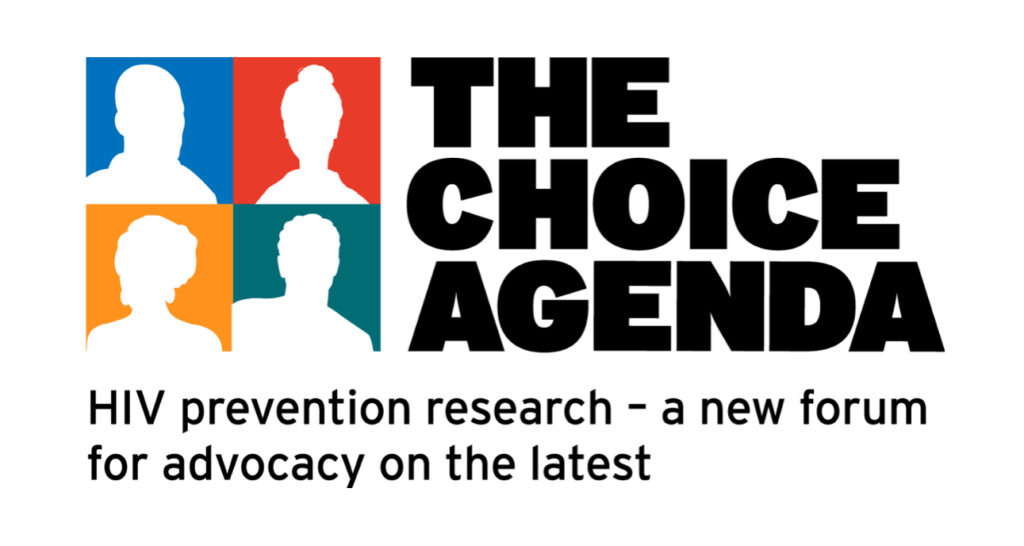
Reporting the African Science Story: Decoding scientific research to support public health in Africa
January 23, 9:30-11:00 am EST
The Media Science Cafés bring together journalists, researchers, implementers, civil society, policy makers, and regulators to build relationships that will foster accurate reporting of HIV, COVID and other science or health stories in those countries. Learn more about this model, lessons learned and why relationships across these fields are a must for advancing HIV prevention and global health.
African Workshop on HIV & Women 2024
February 22-23, 8:30 am-4:30 pm EAT
This regional workshop sponsored by the Academic Medical Education platform of Virology Education is for healthcare providers, researchers, government, industry, and community representatives to increase their knowledge of issues related to HIV and women living in Africa. Early-career investigators will also have opportunities to present their research and meet with experts. Organizers will use this hybrid workshop as a launch for ongoing participant engagement, identifying partnerships, projects and continuing collaboration.
Regular fee deadline, February 8.
Avac Event
African Workshop on HIV & Women 2024
The inaugural edition of the African Workshop on HIV & Women will take place in hybrid format on 22 – 23 February 2024 in Nairobi, Kenya.
The time zone that will be used for this meeting is East Africa Time (EAT). If you need to convert the times to your timezone, this website might be of interest to you: www.WorldTimeBuddy.com.
This exciting new initiative is a regional workshop paired to the annual “International Workshop on HIV & Women”. It is an outstanding opportunity for both local and international healthcare providers, researchers, government, industry, and community representatives to discuss and further increase their knowledge on the issues related to HIV and women living in Africa.
The primary purpose of this workshop is to support changes that will provide a better quality of life for women living with HIV and reduce HIV transmissions in the region.
The format of the workshop enables attendees to learn from renowned HIV experts, discuss challenges, gaps, and opportunities for further learning and research. The debates and roundtables are an especially important vehicle to discuss issues and challenge dogma.
The workshop also provides a forum for early-career investigators to present their research and to personally meet with experts they view as mentors and inspiration for their work.
The meeting organizers hope this workshop will catalyze forming a community, where attendees continue to participate yearly and form valuable relationships and partnerships that lead to collaborative projects and positive changes.
Regular fee deadline, February 8.
Px Pulse: A season of listening
As we look ahead to 2024 and the vital work AVAC and partners will be carrying forward, the conversations from 2023 offer guidance and insights. Px Pulse, AVAC’s podcast on critical issues facing HIV prevention research, hosted several not-be-missed conversations in 2023 that will reverberate into the year ahead.
From a stalled PEPFAR reauthorization to LGBTQIA+ voices fighting persecution in Uganda; from efforts to bring equity to a new global architecture for pandemic readiness to advances in HIV vaccine science and advocacy to include pregnant people in research—we hope that all of these conversations can inform our advocacy in 2024. Click on the episode for both recordings and resources.
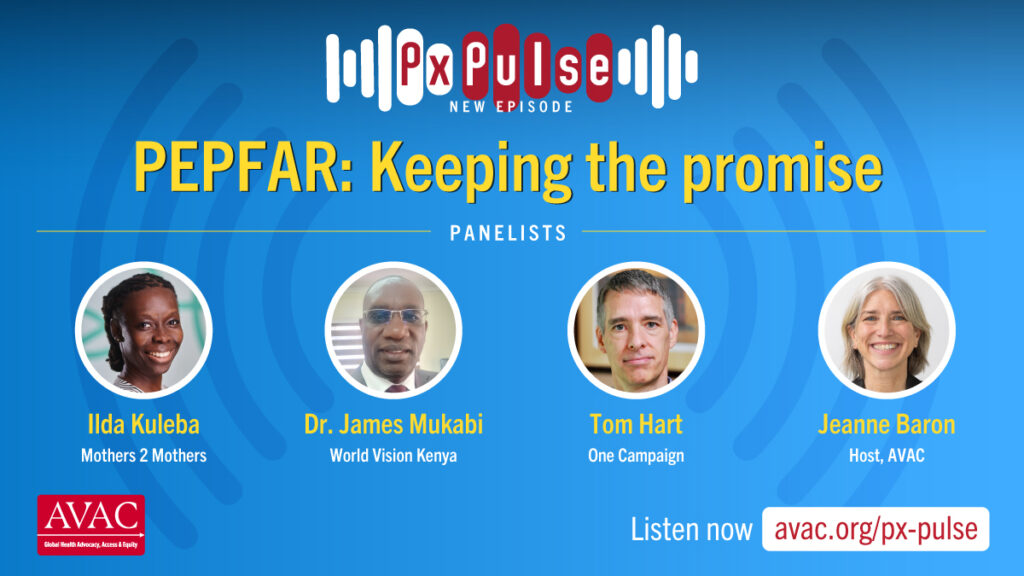
PEPFAR at 20: Keeping the promise (23:16)
Considered one of the greatest US foreign policy and global development achievements of the century, the program has saved upwards of 25 million lives since it launched in 2003. But PEPFAR is marking its 20th anniversary while fighting for its future. LISTEN HERE.
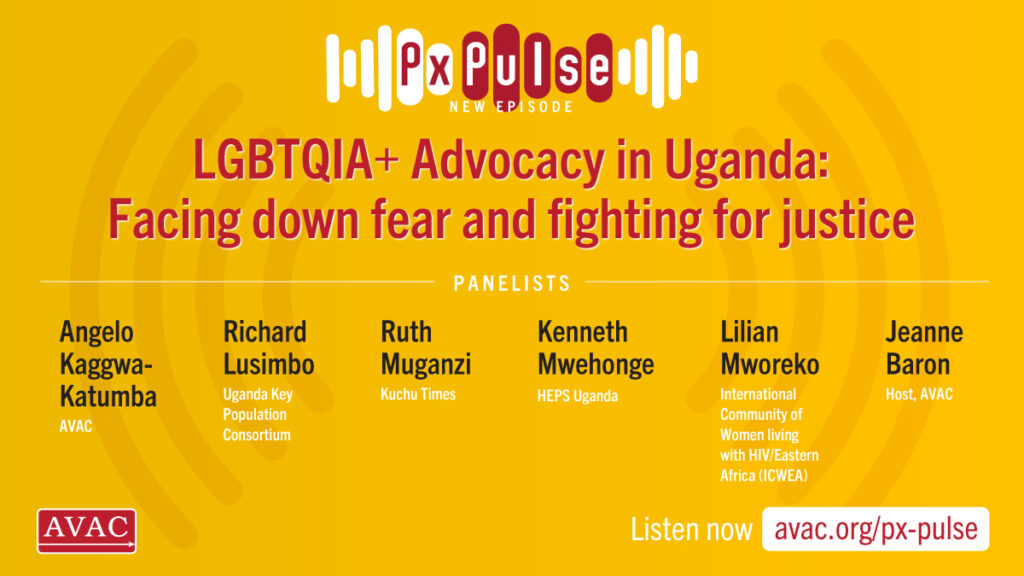
LGBTQIA+ Advocacy in Uganda: Facing down fear and fighting for justice (24:19)
In March 2023, the Ugandan Parliament moved forward broad-reaching legislation to further criminalize LGBTQIA+ people. This podcast features Ugandan advocates and AVAC partners discussing the specifics of how these attacks have gained momentum and their ties to US-based religious extremists. The advocates discuss what needs to happen next. LISTEN HERE.
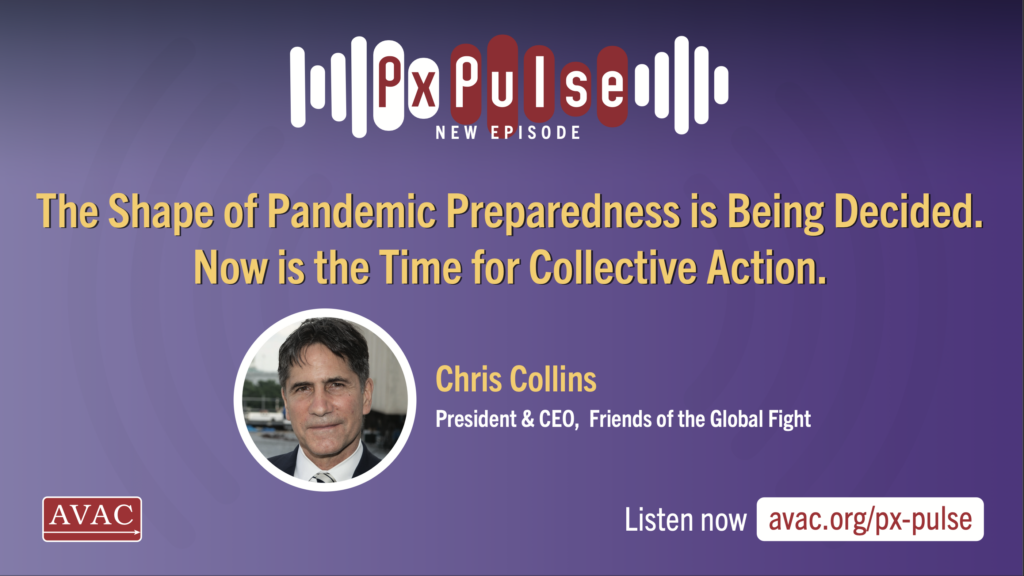
The Shape of Pandemic Preparedness is Being Decided. Now is the Time for Collective Action (15:14)
Health leaders around the world are in the midst of creating a new architecture to deal with pandemics. Chris Collins, the CEO and President at Friends of the Global Fight Against AIDS, Tuberculosis and Malaria, talks about what’s at stake, which policymakers get it already, why this year matters so much, and what advocates can do about it. LISTEN HERE.
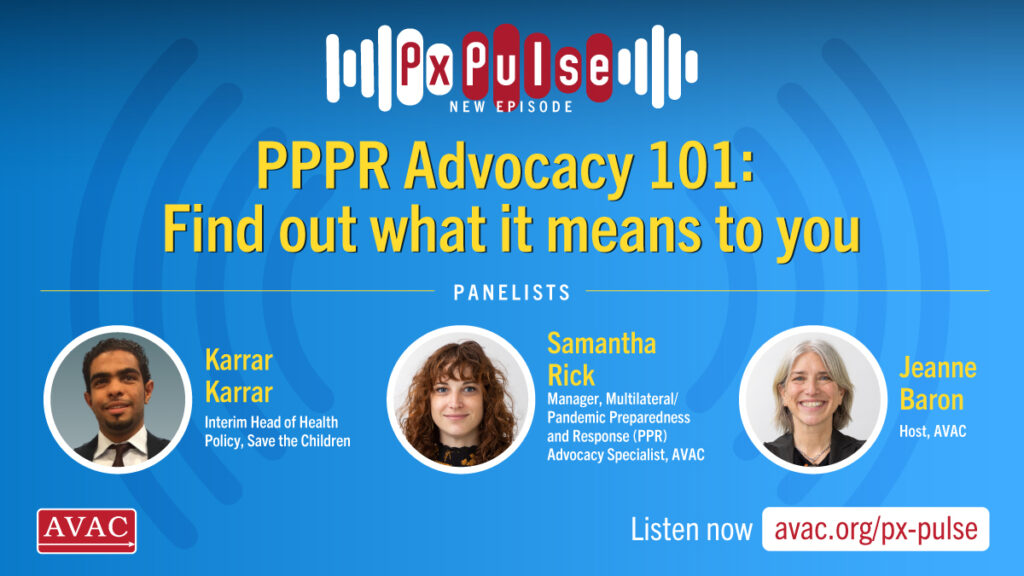
PPPR Advocacy 101: Find out what it means to you (19:05)
Over the coming months, global leaders will make key decisions about several initiatives to prepare for the next pandemic. This podcast explores what they commit to, how much they will spend and how well these plans safeguard equity. LISTEN HERE.
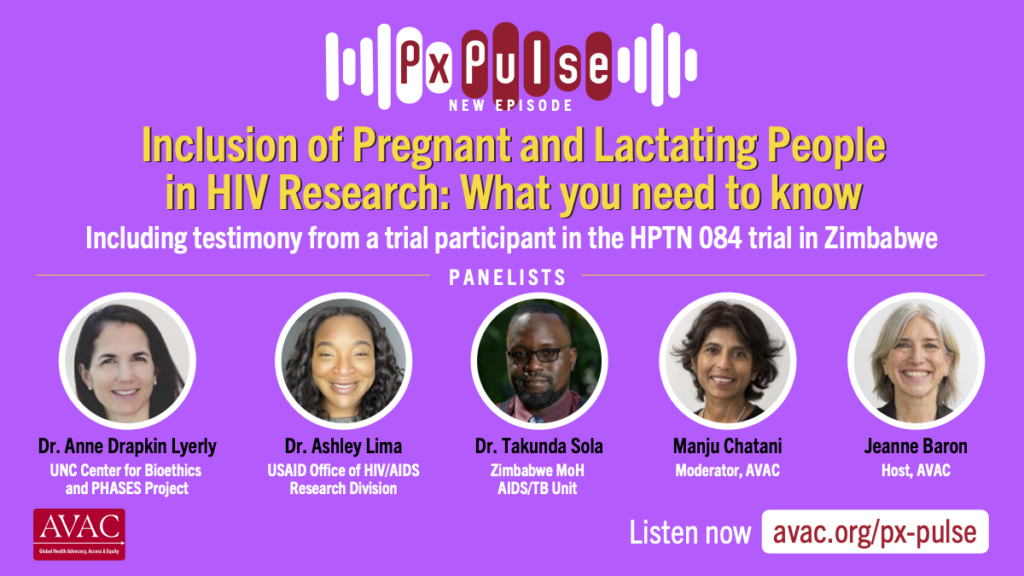
Inclusion of Pregnant and Lactating People in HIV Research: What you need to know (34:28)
AVAC’s Manju Chatani-Gada takes us through conversations with a trial participant who became pregnant, researchers, policymakers and donors to understand why this population gets excluded, the impact it has and what to do about it. LISTEN HERE.
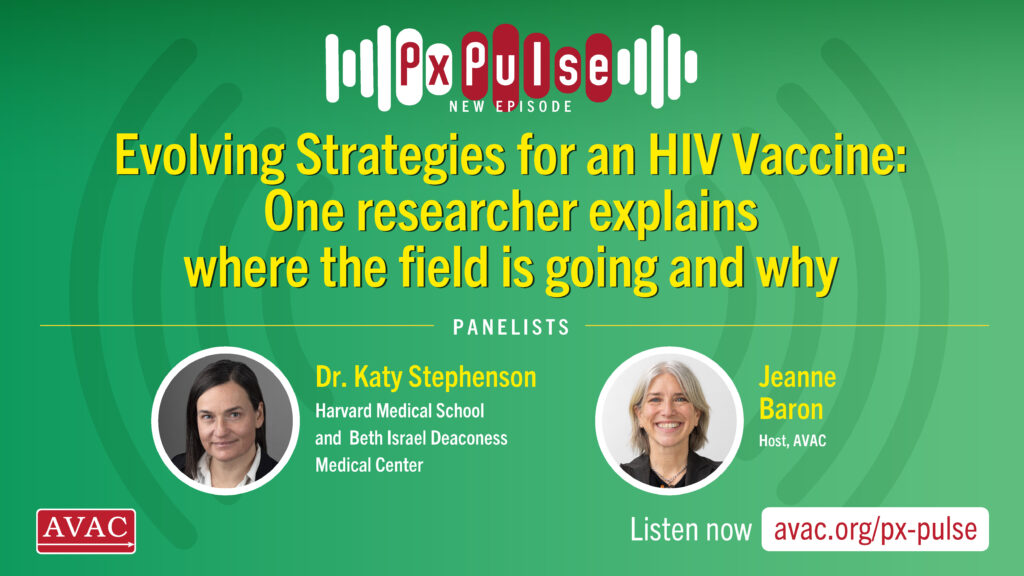
Evolving Strategies for an HIV Vaccine: One researcher explains where the field is going and why? (21:23)
Evolving Strategies for an HIV Vaccine: One researcher explains where the field is going and why? Dr. Katy Stephenson explores the implications of recent trial results, the big questions driving next generation vaccine development, and new strategies underway in early phase research. LISTEN HERE.
Happy listening—and let us know what topics you want to hear more about in 2024!
The “3 Ps” of EmPowerment, Partnership and Protection
This article, co-authored by AVAC’s Jessica Salzwedel, presents stakeholders’ perspectives on the beneficial outcomes of stakeholder engagement in HIV prevention trials.